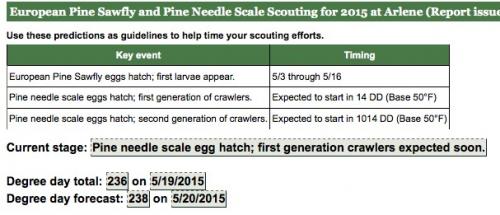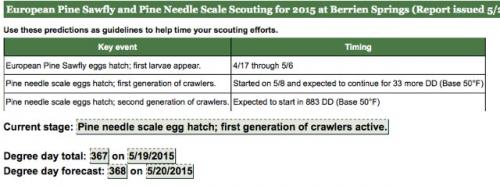Monitor pine needle scale crawlers with Enviro-weather
Use Enviro-weather to estimate when pine needle scale crawlers will be active in your area.

Pine needle scales have hatched or will be hatching soon, as reported by Jill O’Donnell, Michigan State University Extension Christmas tree educator. Like all insects, the growth and development of pine needle scale is driven by temperature. We can roughly predict when life cycle stages will occur using a measure of accumulated heat (growing degree days, or GDD). Research tells us that pine needle scale first generation egg hatch can be predicted at 250 to 400 GDD base 50.
MSU’s Enviro-weather website gives degree-day accumulations for local areas throughout Michigan and can help predict when crucial life stages of pest insects, such as pine needle scales, will occur. Each of Enviro-weather’s 81 weather stations is continually collecting and storing weather data, including temperature, rainfall, etc. Enviro-weather uses the collected data in its research-based models to produce pest and crop management information on the Enviro-weather website.
Enviro-weather’s pine needle scale tool provides estimations of when to expect pine needle scale eggs to hatch and crawlers to appear. These estimations are based on local temperature data collected by Enviro-weather stations.
To access the pine needle scale tool, go to www.enviroweather.msu.edu. From the map shown on the homepage, click the yellow dot for the weather station closest to you. This will take you to the “station page” with detailed weather for that particular weather station.

Arlene Enviro-weather station page.
Next, select “Landscape and Nursery” from the commodity selections in the light green bar at the top of the page. This will take you to the commodity page for that station. Click on the folder next to “Christmas trees” in the column on the left. The folder will open and you will see a list of tools to choose from. Click on “European pine sawfly and pine needle scale.”

Landscape and Nursery tools.
The display shows the predicted estimation of life stage for those insects based on the weather data at the selected station. For example, based on temperatures recorded at the Arlene Enviro-weather station through May 29, 2015, pine needle scale eggs are predicted to hatch in approximately 14 degree-days. The display shows the current life stage “Pine needle scale egg hatch; first generation crawlers expected soon” and gives the degree-day total (236).

Outlook for European pine sawflies in Arlene, Michigan.
Much farther south in Berrien Springs, Michigan, temperatures have been higher and more degree-days have accumulated. If you select the Berrien Springs Enviro-weather station to use with the pine needle scale tool, the display shows a different degree-day total and a different expected life stage. At this location, Enviro-weather estimates that pine needle scale eggs are hatching and crawlers are active. It provides additional information on when egg hatch started (May 8) and how long it will continue for (33 more degree days).

Outlook for European pine sawflies in Berrien Springs, Michigan.
In short, Enviro-weather keeps track of weather conditions in your area and estimates the life stage of pine needle scale and other insects. For more information on this and other Enviro-weather tools and applications, go to www.enviroweather.msu.edu or email eweather@msu.edu.



 Print
Print Email
Email



